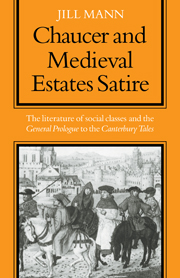Book contents
- Frontmatter
- Contents
- Preface
- List of Abbreviations
- Note on References
- 1 Introduction
- 2 The Anti-Clerical Tradition in Estates Satire
- 3 Estates Ideals
- 4 The Omission of the Victim
- 5 Independent Traditions: Chivalry and Anti-Feminism
- 6 Descriptive Traditions: Beauty and the Beast
- 7 ‘Scientific’ Portraits
- 8 New Creations
- Excursus: The ‘General Prologue’ and the ‘Descriptio’ Tradition
- 9 Conclusions
- Appendices
- Notes
- Selected Bibliography and List of Works Cited
- Index
- Frontmatter
- Contents
- Preface
- List of Abbreviations
- Note on References
- 1 Introduction
- 2 The Anti-Clerical Tradition in Estates Satire
- 3 Estates Ideals
- 4 The Omission of the Victim
- 5 Independent Traditions: Chivalry and Anti-Feminism
- 6 Descriptive Traditions: Beauty and the Beast
- 7 ‘Scientific’ Portraits
- 8 New Creations
- Excursus: The ‘General Prologue’ and the ‘Descriptio’ Tradition
- 9 Conclusions
- Appendices
- Notes
- Selected Bibliography and List of Works Cited
- Index
Summary
It is a cliché of Chaucer criticism that the Canterbury pilgrims are both individuals and types. But this critical unanimity coexists with striking divergencies on what constitutes the typical or the individual.
One could begin by suggesting that the ‘individual’ quality is that which distinguishes one person from other people. But this cannot be a single character-trait, since financial greed, for example, is a feature of both Friar and Pardoner. Is individuality constituted by the peculiar combination of traits? Unfortunately, this is precisely what some critics take to be the typical. For example, Root thought that the combination of ‘individualising traits’ in the Prioress's portrait suggests ‘that type which finds fullest realisation in the head of a young lady's school’. The ‘individual’ is then reduced to the level of ‘a local habitation and a name’; ‘the Wife of Bath is typical of certain primary instincts of woman, but she is given local habitation “bisyde Bathe”, and is still further individualised by her partial deafness and the peculiar setting of her teeth.’
J. L. Lowes also seemed to accept that ‘the typical’ refers to general outlines of personality when he praises ‘the delicate balance between the character, in the technical, Theophrastian sense of the word, and the individual – a balance which preserves at once the typical qualities of the one and the human idiosyncrasies of the other.’
- Type
- Chapter
- Information
- Chaucer and Medieval Estates Satire , pp. 187 - 202Publisher: Cambridge University PressPrint publication year: 1973



